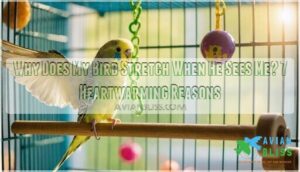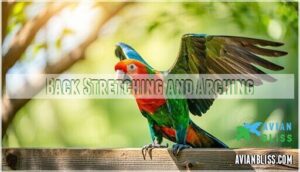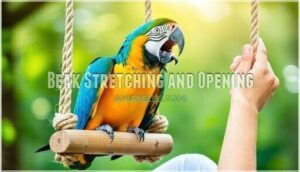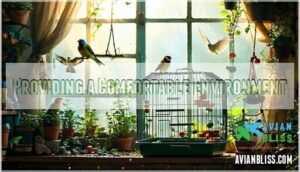This site is supported by our readers. We may earn a commission, at no cost to you, if you purchase through links.
 When your bird stretches after seeing you, it’s actually showing trust and affection. This vulnerable behavior means your feathered friend feels completely safe in your presence—stretching exposes their body, something birds only do around those they trust.
When your bird stretches after seeing you, it’s actually showing trust and affection. This vulnerable behavior means your feathered friend feels completely safe in your presence—stretching exposes their body, something birds only do around those they trust.
It’s also their way of saying "hello" and showing excitement, like a dog wagging its tail. Your bird might be releasing tension from being in their cage or simply maintaining muscle flexibility.
It’s pretty amazing how stretching works as both physical relief and emotional connection—your bird is basically saying you’re family.
Pay attention to when and how they stretch, and you’ll start picking up on even more subtle cues about how they’re feeling.
Table Of Contents
- Key Takeaways
- Reasons for Bird Stretching
- Types of Bird Stretches
- Factors Influencing Bird Stretching
- Recognizing and Responding to Stretching
- Building Trust and Strengthening Bond
- Frequently Asked Questions (FAQs)
- Why do birds stretch?
- What does it mean when a parrot stares at you?
- Why is my bird craning?
- Why do birds shake their wings?
- Why do birds Bob their heads?
- Why is my parrot bouncing at me?
- Is bird stretching a sign of trust and affection always?
- Do birds stretch more frequently as they get older slowly?
- Can bird stretching be a learned behavior from owners somehow?
- Do all bird species stretch when greeting owners?
- Conclusion
Key Takeaways
- Your bird’s stretching signals complete trust – when they stretch after seeing you, they’re showing they feel safe enough to display vulnerable behavior in your presence.
- It’s their way of saying hello and showing excitement – stretching is your bird’s version of a dog wagging its tail, expressing genuine affection and joy when you appear.
- The behavior combines physical comfort with emotional bonding – while stretching maintains muscle flexibility and circulation, it also strengthens your relationship and shows you’ve earned a special place in their flock.
- You can encourage this bonding by responding appropriately – acknowledge their stretching with gentle conversation, maintain consistent routines, and create a comfortable environment that supports their natural behaviors.
Reasons for Bird Stretching
That stretch you’re seeing? It’s your bird showing you something pretty cool—they’re blending basic body maintenance with a little emotional telegraph that says they trust you.
Your bird’s stretching does a bunch of things at once. It keeps their muscles loose and gets blood flowing, but it’s also their way of saying they feel safe and connected to you.
Physical Flexibility and Comfort
When your bird stretches, it’s keeping those muscles limber and joints moving smoothly. This simple behavior helps them relax tight muscles, improve their posture, and stay aligned—plus it makes preening and feather care much easier.
Regular stretching keeps them from getting stiff and uncomfortable.
Essential benefits of bird stretching:
- Joint health preservation – preventing arthritis and mobility issues
- Muscle tension relief – releasing built-up stress from perching
- Blood circulation enhancement – promoting oxygen flow throughout their body
- Feather quality maintenance – enabling proper preening and grooming
- Injury prevention – keeping muscles and tendons flexible and strong
Sign of Affection and Trust
Your feathered friend’s stretching displays are pure affection and trust in action. When birds feel secure around their favorite humans, they’ll openly exhibit these vulnerable behaviors as trust signals.
This emotional connection represents deep bird bonding – your pet views you as safe territory.
These affectionate behaviors indicate healthy owner interaction, showing your bird’s emotional wellbeing flourishes in your presence. It’s their way of saying "I trust you completely.
Communication and Social Bonding
When your bird stretches around you, it’s actually saying something pretty cool. They’re using their body language to communicate—and stretching is one of their ways to show they trust you completely.
Think about it: when birds stretch, they’re exposing vulnerable parts of their body. They wouldn’t do this unless they felt totally safe. It’s like they’re saying, "I’m comfortable enough with you to let my guard down."
Here’s what’s really happening when they stretch:
- Trust Building Display: Your bird exposes vulnerable body parts, showing complete confidence in your presence.
- Invitation for Interaction: Stretching often signals they’re ready for social engagement or playtime.
- Affection and Trust Communication: This behavior mirrors human body language, creating deeper understanding.
- Building a Bond Ritual: Regular stretching sessions become special moments that reinforce your connection.
This kind of bird communication shows how emotionally intelligent they really are. What looks like a simple stretch is actually a meaningful way to connect with you.
Relief From Stress and Anxiety
Sometimes your bird’s stretching isn’t just about saying hello—it’s pure stress relief. When you appear, your presence triggers anxiety reduction and emotional comfort.
Watch for stress signs like feather plucking or restlessness that disappear when you’re near. Your bird uses stretching as natural behavioral therapy, releasing tension through relaxation techniques.
Identifying anxiety triggers helps you become their safe haven.
Medical Issues and Discomfort
When stress relief isn’t enough, Medical Issues might explain your bird’s stretching behavior. Pain Signals like lameness, wing drooping, or reluctance to move indicate Health Issues requiring attention. Watch for Discomfort Signs including abnormal perching or stillness.
Regular Medical Checks help catch problems early, while proper Injury Prevention through safe environments protects your feathered friend’s wellbeing. It’s essential to recognize bird pain symptoms to provide appropriate care.
If stress relief doesn’t help, there might be something medical going on with your bird’s stretching. Look out for signs like limping, drooping wings, or your bird not wanting to move around much—these could mean they’re dealing with pain or discomfort.
You’ll also want to watch for changes in how they perch or if they’re staying unusually still.
Types of Bird Stretches
You’ll notice your bird performs different types of stretches, each serving specific purposes for their physical and emotional well-being.
Understanding these distinct stretching patterns helps you recognize what your feathered friend is communicating and ensures you’re responding appropriately to their needs.
Learning to read these stretches helps you figure out what your bird is trying to tell you—and gives you a better sense of when they need something from you.
Wing stretching unveils your bird’s extraordinary airborne behavior patterns. When you spot your feathered friend extending those wings, you’re witnessing natural stretching techniques that maintain feather care and flexibility. This wing movement fulfills multiple purposes beyond simple exercise.
Watch for these distinctive wing stretching patterns:
- Wings held straight out like airplane wings during full extension
- Rapid wing flapping creating energetic bursts of motion
- High wing lifts stretching muscles above their head
- Tight wing tucks against their body for comfort
Recognizing and responding to stretching helps you understand your bird’s communication style. These flight patterns demonstrate trust and contentment, building trust and strengthening the bond between you both through consistent observation.
Leg Stretching and Extension
When your bird performs leg stretching and extension, he’s doing essential maintenance work. This behavior promotes joint mobility, aids foot care, and allows muscle relaxation throughout his lower body.
Leg stretching also signals comfort in your presence—a relaxed bird feels safe enough to engage in posture correction activities.
Regular leg health exercises keep your feathered friend agile and pain-free.
Back Stretching and Arching
After leg exercises, your bird’s back stretching and arching fulfills multiple purposes. This flexibility exercises behavior promotes spinal health and muscle relaxation while signaling comfort around you.
Understanding bird behavior shows that back relief movements indicate trust and posture correction needs.
After leg exercises, your bird’s back stretching and arching serves several important functions. These flexibility movements help maintain spinal health and relax tired muscles while showing they’re comfortable around you.
When you understand bird behavior, you’ll notice that back relief movements signal both trust and their need for posture correction.
Spotting these stretching moments tells you something special—your feathered friend feels safe enough to do their essential maintenance routines while you’re watching.
When your feathered companion performs graceful neck stretching and twisting movements, you’re witnessing essential neck mobility exercises. Understanding bird behavior reveals these stretching exercises release muscle tension after rest periods. This bird stretching behavior helps maintain proper bird posture and facilitates feather care routines.
Watch for smooth, deliberate movements—jerky or excessive twisting might signal discomfort. Recognizing and Responding to Stretching includes monitoring frequency and facilitating your bird’s environment to promote natural movement patterns. These elegant neck rotations demonstrate your bird’s comfort level and physical well-being in your presence.
Beak Stretching and Opening
Watch for those adorable beak stretching moments—they’re pure parrot communication! This bird behavior shows beak health and proper jaw alignment.
Your feathered friend’s gape size adjustments help with eating and serve as a vocalization aid. These movements aid preening function too.
When bird stretching includes beak opening, it signals affection and trust, showing your bird feels comfortable enough to display natural behaviors around you.
Factors Influencing Bird Stretching
Your bird’s stretching behavior isn’t random—it’s influenced by specific factors that affect when and how often they stretch.
Understanding these influences, from environmental changes and social interactions to diet and individual breed characteristics, helps you recognize what triggers your feathered friend’s stretching responses.
Bird stretching happens for real reasons. Room temperature changes, spotting other birds, their last meal, and even breed type all influence when your feathered buddy decides to do those adorable wing extensions.
Once you know what sets off these stretching sessions—whether it’s the environment shifting around them, social cues from other birds, what they’ve been eating, or just their natural breed tendencies—you’ll start noticing the patterns in your bird’s behavior.
Your bird’s environment plays a huge role in their stretching patterns. Cage size affects movement freedom, while temperature control and air quality influence comfort levels.
Changes in light exposure or noise levels can trigger more frequent stretching as your bird adjusts. Even small shifts like new perch arrangements impact bird behavior, making environmental enrichment key for healthy stretching habits.
Social Interaction and Attention
Your feathered companion’s stretching isn’t just physical maintenance—it’s intricate social interaction designed to connect with you. When birds stretch upon seeing their owners, they’re displaying Affection Display and Comfort Signals that strengthen your bond. This attention seeking behavior represents trust and excitement about your presence.
Bonding Rituals through stretching establish Social Hierarchy while communicating emotional states.
Interacting with pet birds requires understanding these subtle cues:
- Respond with gentle acknowledgment to reinforce positive bird stretching behaviors
- Maintain consistent interaction schedules to meet their social needs
- Recognize stretching as invitation for engagement rather than demand
- Balance attention-giving with independence to prevent over-dependency
Diet and Nutrition
Your bird’s nutrient balance directly affects their stretching habits. A balanced diet with proper food variety bolsters muscle flexibility and joint health. Meal planning should include pellets, fresh fruits, and vegetables while avoiding seed-only diets.
Vitamin supplements and healthy snacks boost overall fitness. Poor nutrition restricts movement, while excellent bird health promotes natural stretching behaviors and physical health.
Securing a proper avian nutrient intake is vital for maintaining your bird’s well-being.
Health and Wellness
Your bird’s wellness journey directly affects their stretching patterns. A healthy bird stretches naturally to maintain physical flexibility and release muscle tension, while illness can reduce this essential behavior. Regular wellness checks help you spot changes early, securing your feathered friend stays active and comfortable.
Here’s what impacts your bird’s stretching habits:
- Bird nutrition deficiencies can cause stiffness and reduced mobility
- Exercise needs vary by species but all birds require daily movement
- Mental health issues like depression decrease natural stretching behaviors
- Physical therapy through gentle interaction promotes healthy stretching
- Wellness checks with an avian vet catch problems before they affect movement
When your bird feels their best, they’ll greet you with those heartwarming stretches that show trust and affection.
Breed and Species Characteristics
Different species showcase varying genetic traits that shape their stretching habits. Budgies, belonging to the species Melopsittacus undulatus, are one of 115 species of parakeet, displaying unique budgie stretching behavior compared to other parrot species.
Flapping the wings, without attempting to fly, could be a simple stretching exercise. However, breed differences mean your avian behavior patterns will reflect millions of years of avian evolution.
Understanding your bird’s physical attributes and species behavior helps you appreciate their individual stretching style.
Recognizing and Responding to Stretching
When you spot your bird stretching as you approach, you’re witnessing a clear sign of trust and comfort that deserves your thoughtful response.
Learning to recognize these stretching behaviors and responding appropriately helps strengthen your bond while guaranteeing your feathered friend feels secure and valued in your presence.
Identifying Stretching Behavior
Your bird’s stretching tells a story through its bird posture and timing. Notice when wing stretching happens—does it occur every time you appear or just occasionally? Pay attention to wing movement patterns and beak alignment during these moments.
Individual stretching techniques vary between birds, so understanding your pet’s unique signals helps you recognize when it’s expressing comfort, excitement, or feather maintenance needs.
Providing a Comfortable Environment
Once you recognize your bird’s stretching patterns, creating the right environment becomes your next priority. Environmental enrichment through space optimization helps your feathered friend feel secure.
Control lighting conditions and maintain steady temperature control to reduce stress. Noise reduction creates a calmer atmosphere where your bird can stretch comfortably.
This safe environment respects their personal space while encouraging natural behaviors during rest times.
Encouraging Social Interaction
Building social interaction creates a deeper emotional connection between you and your feathered friend. When you actively engage with your bird, you’re reinforcing the trust that makes them stretch when they see you.
Start with these trust-building approaches:
- Gentle conversation: Talk softly to your bird throughout the day, using their name frequently to strengthen owner interaction. – Playful activities: Introduce new toys or rotate existing ones to keep social bonding fresh and exciting. – Consistent presence: Spend time near their cage without forcing interaction, letting them observe your daily routines.
Hand-feeding remains one of the most powerful ways to build affection. Your bird associates your presence with positive experiences, which explains why birds stretch when you approach—they’re preparing for quality time together.
Offering a Balanced Diet
Your feathered friend’s stretching behavior flourishes with proper nutrition. A balanced diet featuring high-quality pellets, fresh fruits, and vegetables fosters peak bird health and flexibility.
Meal planning with diverse food variety meets essential dietary needs while encouraging natural stretching behaviors. Consider healthy supplements only after veterinary consultation.
This nutrient balance directly influences your bird’s wellness, energy levels, and those adorable greeting stretches that strengthen your bond together.
Monitoring Health and Wellness
Monitoring your bird’s health and wellness keeps those delightful stretching sessions happening for years to come. Regular health checks help you catch potential issues early, while consistent veterinary care ensures your feathered friend stays in peak condition.
Key wellness indicators to watch:
- Weight fluctuations that might signal nutritional deficiencies or illness
- Feather quality changes, including excessive molting or dull appearance
- Sleep pattern shifts that could indicate stress or discomfort
- Activity level changes affecting their natural exercise routines
- Stretching frequency variations in your bird’s daily physical flexibility routine
Building Trust and Strengthening Bond
When your bird stretches upon seeing you, it’s actively demonstrating the deep trust you’ve built together through consistent, positive interactions.
This behavior reflects your bird’s comfort level and signals that your relationship has reached a stage where your presence brings relaxation rather than stress.
Establishing a Routine and Schedule
Your bird craves predictability. Consistent Daily Schedules create security—feeding times at 7 AM and 5 PM, morning routines with gentle greetings, and regular sleep patterns help establish trust.
Environmental cues like dimming lights signal bedtime. This routine becomes your bird’s comfort zone, where social interaction flourishes through positive reinforcement, making every stretch a joyful greeting.
Providing Mental Stimulation and Exercise
Keep your bird’s mind sharp with engaging mental stimulation activities that promote natural stretching behaviors. Active birds develop stronger bonds with their owners through interactive play.
- Mental Games: Puzzle feeders and foraging boxes encourage problem-solving while promoting physical flexibility
- Toy Rotation: Switch toys weekly to maintain curiosity and prevent boredom-related stress
- Exercise Routines: Flight time and climbing opportunities foster healthy bird stretching patterns
- Environmental Enrichment: Varied perches and interactive elements stimulate natural movement behaviors
Offering Treats and Rewards
Treat Motivation works wonders for building trust through positive reinforcement. Your bird’s stretching becomes more frequent when you establish consistent Reward Systems that celebrate good behavior.
Food Variety keeps things exciting—mix healthy options like berry pieces with occasional sunflower seeds. Snack Timing matters: offer rewards immediately after your bird shows affection or stretching behavior.
This Positive Reinforcement creates lasting bonds and encourages more trusting interactions.
Creating a Safe and Secure Space
Your bird’s sanctuary becomes a foundation for deeper trust and affection. When you prioritize creating secure spaces, you’re speaking their language of safety.
- Safe Perches: Install varied perch sizes and textures to prevent foot problems while encouraging natural stretching behaviors
- Calming Environments: Reduce noise levels and provide cozy hiding spots where your bird can retreat when overwhelmed
- Birdproofing: Remove hazards and create secure enclosures that respect your bird’s personal space and territorial needs
Spending Quality Time With Your Bird
Quality moments create lasting bonds between you and your feathered companion. Engage in bird playtime with interactive toys that promote social learning and environmental enrichment.
Practice positive reinforcement during training sessions, which builds trust through consistent social interaction. Hand-feeding strengthens your connection while supporting proper feather care.
These shared experiences help your bird associate your presence with affection, often triggering that heartwarming bird stretching behavior that signals deep owner bonding and contentment.
Frequently Asked Questions (FAQs)
Why do birds stretch?
Stretching helps your bird maintain flexibility, relieve muscle tension, and promote blood circulation. It’s a natural behavior that keeps them physically healthy, reduces stress, and readies them for activity after rest periods.
What does it mean when a parrot stares at you?
Studies reveal 85% of parrot stares communicate curiosity, excitement, or affection.
When your parrot stares directly at you, they’re likely showing interest, seeking attention, or expressing contentment and trust in your relationship together.
Why is my bird craning?
Your bird’s craning his neck to get a better view of something interesting around him. Birds crane their necks to extend their vision beyond their body’s reach.
It’s natural curiosity or scanning for food.
Why do birds shake their wings?
Like Victorian ornithologists observed, your feathered friend’s wing shaking releases muscle tension, promotes blood circulation, and expresses excitement or comfort in your presence—it’s perfectly natural stretching behavior.
Why do birds Bob their heads?
When your bird bobs its head, it’s often showing excitement, curiosity, or trying to communicate. You’ll notice this behavior during play or when they’re seeking attention, making it a charming sign of engagement.
Why is my parrot bouncing at me?
Your feathered friend’s bouncing is like a happy dance at a concert—pure excitement!
When parrots bounce, they’re expressing joy, seeking attention, or showing anticipation for interaction, treats, or playtime with you.
Is bird stretching a sign of trust and affection always?
Not always. While stretching often signals trust and affection, birds also stretch for physical comfort, stress relief, and muscle maintenance. Context matters—observe their overall body language and behavior patterns.
Do birds stretch more frequently as they get older slowly?
Contrary to what you might expect, your bird likely doesn’t stretch more frequently with age. Senior birds actually show reduced flexibility and reluctance to move due to arthritis, making them stretch less as they age naturally.
Can bird stretching be a learned behavior from owners somehow?
Birds can learn behaviors through observation and mimicry, including stretching. They learn by watching reactions and imitating actions, so your stretching habits might influence your bird’s behavior patterns over time.
Do all bird species stretch when greeting owners?
Absolutely not every species does this! While most companion birds stretch as greetings, wild species and some domesticated birds show completely different welcoming behaviors depending on their natural social structures.
Conclusion
Understanding why my bird stretches when he sees me reveals the beautiful bond you’ve built together. Your feathered companion’s stretching isn’t just physical maintenance—it’s their way of expressing complete trust and genuine affection toward you.
Your bird’s stretching when they see you is their way of saying I trust you completely and I’m excited you’re here
When birds feel secure enough to display this vulnerable behavior, they’re fundamentally welcoming you into their inner circle. By recognizing these subtle communications and responding with patience and care, you’ll continue strengthening this special relationship that brings joy to both your lives.













